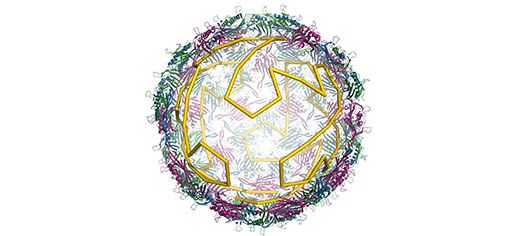
A new study has solved a long-standing puzzle of how common viruses reproduce themselves during an infection, opening up new possibilities for treating a range of diseases from HIV to the common cold.
“Levinthal’s Paradox” has perplexed scientists since the late 1960s and is founded on the enormous number of pathways virus particles could theoretically use to assemble themselves into their protective shells. If they used a simple trial and error strategy, it would take many days to form a virus, but all the evidence suggests that they assemble within seconds or minutes.
An experimental team at the University of Leeds and mathematicians at the University of York have developed a mathematical model to explain how RNA viruses solve this enormously complicated “Rubik’s cube” in microseconds or milliseconds.
By incorporating multiple specific contacts between the genomic RNA and the proteins in the virus’s containers, and other details of real virus infections, the research team’s mathematical model demonstrates how these contacts act collectively to reduce the complexity of virus formation.
This process also ensures efficient and selective packaging of the viral genome and has evolved because it provides significant selective advantages to viruses that operate this way.
The mathematical model could open up new opportunities for anti-viral therapies targeting a fundamental process in the formation of a wide range of viruses and could be a significant step in the fight against diseases including HIV, Hepatitis B and C, the winter vomiting bug Norovirus and the common cold.
Professor Peter Stockley, of the Astbury Centre for Structural Molecular Biology at the University of Leeds, said: “We have already obtained proof of principle in a simple model virus that these functions can be targeted by drugs. The new opportunities for anti-viral intervention opened up by our paper also apply to viruses for which therapeutic options are currently limited. The new approach is enticing because it enables us to target co-operative aspects of viral assembly that are conserved across different viral strains, making it less likely that drug therapy would elicit resistance mutations.”
Professor Reidun Twarock, of the Departments of Mathematics and Biology at the University of York, who led the study, said: “This truly interdisciplinary effort has provided surprising insights into a fundamental mechanism in virology. Existing experimental techniques for studying viral assembly are unable to identify the cooperative roles played by all the important components, highlighting the need for and power of mathematical modelling. This model is a paradigm shift in the field of viral assembly. It sheds new light on virus assembly in a major class of viruses and their evolution, and opens up a novel strategy for antiviral therapy.”
Further information
Professor Peter Stockley is available for interview.
Contact: Chris Bunting, Senior Press Officer, University of Leeds; phone: +44 113 343 2049 or email c.j.bunting@leeds.ac.uk.
The paper 'Solving a Levinthal's paradox for virus assembly identifies a